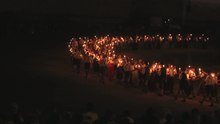Torch dance
When Fackeltanz or candle dance wearing dancers burning torches in their hands or burning candles on their heads while they walk their dance moves.
Historical
The torch dance was in ancient times a dance similar to the polonaise , in which the dancers carried torches made of wax in their hands. Such dances were already part of the wedding celebrations in ancient Greece and Rome . Constantine the Great had the dance included in court ceremonies around the year 300 . The dance was used by many German princely houses from the Middle Ages to the 18th century and was also danced at the courts of France, England and Denmark.
The Prussian royal family even practiced this custom in 1913 when the daughter of Wilhelm II. Viktoria Luise von Prussia married the Duke of Brunswick Ernst August . Twelve dignitaries or pages carried burning torches ahead in the dance. The bride and groom made the first meeting alone, then the bride asked the king and then the other princes. Then the groom danced with the queen and princesses. There was a similar ceremony at the French court.
The torch dance in folk dance
In many countries, torch dances with different choreographies have been handed down in folk dance, for example in Austria, Bavaria, Pomerania, Poland, Lithuania and Spain. There are special traditional dance forms as listed below. But also a number of common dances are performed with torches for reasons of tradition or for reasons of sight.
Torch relays
The torch relay on Easter Vigil, which has been handed down in Carinthia, can also be described as a kind of dance . The farmers light Easter bonfires, everyone in his field, and they light their wooden torches with them, move them single file across the fields, walk in serpentine lines, line up in the form of crosses, diamonds or stars. They spin around themselves so that their torches act like fiery wheels, dance twists and turns, throw the torches over the steep mountain meadows and jump after them. They throw the torches into the embers at the neighbor's Easter fire. This should promise a rich harvest.
Wedding dance
Especially in wedding customs, dances with candles on their heads have been handed down in many countries or used to be common. Sometimes the bride, a dancer or the best dancers wears a candle-tipped Gugelhupf (wreath cake) on their heads. One of the candles is extinguished with each round. The Gugelhupf is then consumed together.
Guild dance
In the Middle Ages, some craftsmen's guilds formed the torch dance into a figure-rich show dance in many cities, which was performed for the glory of their craft and to honor people, but also on the occasion of weddings. Something like this has come down to us in Tyrol and Salzburg. These dance forms were probably similar to the sword dance or maturity dance . From older references to such dances, Karl Horak re- formed such a dance, which is performed more often, especially in Tyrol.
Salzburg torch dance
Every year at the opening of the Salzburg Festival, over 100 dancers dance the great Salzburg torch dance around the Residenzbrunnen in Salzburg's old town. This custom was redesigned in 1951, based on old customs and medieval guilds.
literature
- Ilka Peter : The Salzburg Torch Dance , 1979. Verlag der Salzburger Druckerei, Salzburg
See also
Web links
- Video of the Salzburg torch dance ( WMV ; 71.7 MB)
